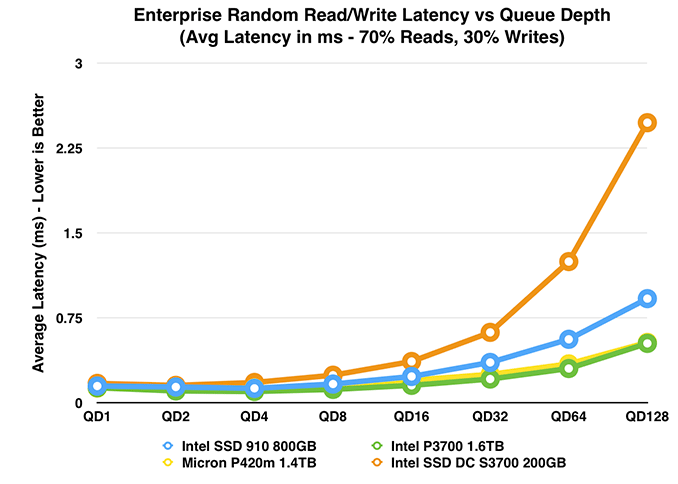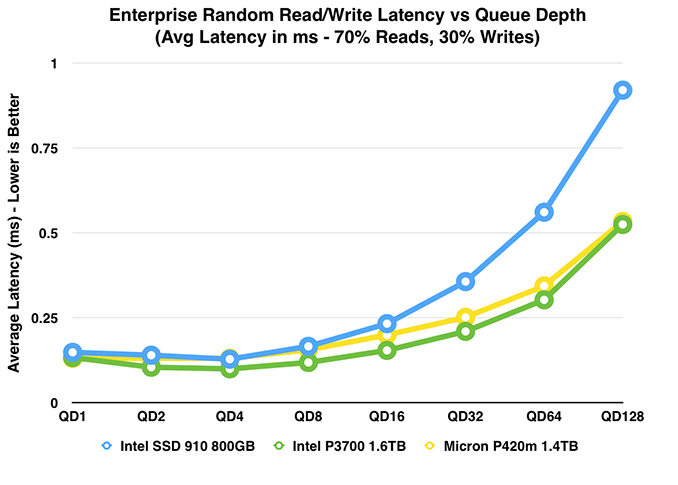Intel SSD DC P3700 Review: The PCIe SSD Transition Begins with NVMe
by Anand Lal Shimpi on June 3, 2014 2:00 AM EST- Posted in
- Storage
- SSDs
- Intel
- Intel SSD DC P3700
- NVMe
Mixed Read/Write Performance
Although our four corner testing is useful, many real world enterprise workloads are composed of a mixture of reads and writes. OLTP environments in particular tend to see a 70/30 split between reads and writes. The test below is conducted the same way as our 4KB random write test (1 sequential drive write, 1 4K-QD128 random drive write, then 3 minute test), but the actual test is 70% reads and 30% writes.

The results here look a lot like the 4KB random read results, but with a slightly different slope. The P3700 and Micron's P420m compete for top billing, but the P3700's superior random write performance and solid midrange queue depth random read performance ultimately give it the edge here.












85 Comments
View All Comments
extide - Tuesday, June 3, 2014 - link
Yeah, this except more correctly it is SATA vs PCIe as the interface and AHCI vs NVMe as the protocol.Connectors:
M.2 --> Supports AHCI over SATA, AHCI over PCIe, and NVMe over PCIe
SFF-8639 --> Supports AHCI over PCIe and NVMe over PCIe
PCIe card --> AHCI over PCIe, and NVMe over PCIe
Now the latter 2 (and even the first one if you really wanted to...) could have a PCIe based SATA controller on it which would go PCIe --> SATA/SATA RAID Controller -> SATA SSD Controller(s), (For example this is how the OCZ Revo Drive works)
Galatian - Wednesday, June 4, 2014 - link
That's not what I meant with my comment. I'm upset that besides ASRock on the Extreme 6 and 9 and ASUS on their Impact no other manufacture included a higher bandwidth M.2 connector. I guess all upcoming PCIe M.2 drives will already be bottlenecked by the lackluster M.2 speeds most mainboard manufactures are building into their products,hpvd - Tuesday, June 3, 2014 - link
hmmm are you sure? no new mainboard needed? No new Bios? Should it work in all boards which could boot existing PCIe SSDs?hpvd - Tuesday, June 3, 2014 - link
I would really appreciate a short test of this. How should this work when AHCI is the standard on todays Mainboards/Bios/UEFI? There is alreday some work done until the Windows-/Linux driver take over the helm(which is of course already available: http://www.nvmexpress.org/blog/open-fabrics-allian...
TelstarTOS - Tuesday, June 3, 2014 - link
404j00d - Friday, June 6, 2014 - link
just take off the trailing ) in the urlRyan Smith - Tuesday, June 3, 2014 - link
Since a couple of you asked, I threw it in our X79 testbed.Windows 8.1U1 sees the drive without issue, however it is not bootable as our motherboard cannot see the drive as a bootable devices. I preface that with the fact that our X79 testbed is a consumer platform (ASRock X79 Professional) and X79 is a rather old chipset. So I can't speak for how this would behave on a brand spanking new Z97 board, or a server board for that matter.
hpvd - Wednesday, June 4, 2014 - link
many thanks for giving this a try! Should be further investigated...hpvd - Wednesday, June 4, 2014 - link
PCIe booting may be a general prob with standard bios setting on these boards. I found a tiny bios setting guide how to fix this (on a similar Asrock X97 board). Would be awesome If you could try this:http://www.oczforum.com/forum/showthread.php?10114...
You would be the very first in web booting from an NVMe device :-)
hpvd - Wednesday, June 4, 2014 - link
the other way around the question is:does
- your board
- with this bios version
- with this bios settings
- in this PCIe slot
see other bootable PCIe SSD devices?
if so this new Intel PCIe NVMe SSD behave somehow different
If others couldn't be seen either - there is still hope for "normal" boot support :-)
You just have the right board, bios settings...